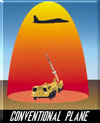
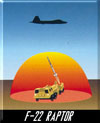
Technical dataabout the F-22's |
| Board Computer History |
Get StealthyTo make a stealthy aircraft, designers had to consider five key ingredients: - reducing the imprint on radar screens / stifling radio transmissions
To understand more about each ingredient, here is some theory first. Radar Cross section (RCS) The first goal is to cut down the size of the aircraft's radar image, called its "radar cross section," or RCS. This normally involves using radical design features and some nonmetallic materials. |
 |
 |
|
A conventional fighter aircraft has an Radar Cross Section (RCS) in the
region of 6 square metres. The much larger B-2B bomber, using the latest
stealth technology, displays an RCS of only 0.75 square metres. By comparison,
a bird in flight displays an RCS of 0.01 square metres. Radar echo reductionThis section explains more about what radar echos look like and how they can be prevented to reach the radar receiver again after hitting the plane. ScatteringCurving surfaces on conventional aerodynamic bodies act as scatterers, reflecting radar waves from any angle and giving the radar operator a clear signal. The right-angled surfaces at the wing and tail roots also reflect radar signals straight back to their source. Scintillation is a measure of how rapidly the size of the return varies with the angle. The greater this variation, the more difficult a target is to track. The lower the number of lobes and the narrower the lobes, the lower the probability of detecting any return. A flat plate at right angles to an impinging radar wave has a very large radar signal, and a cavity, similarly located, also has a large return. Thus the inlet and exhaust systems of a jet aircraft would be expected to be dominant contributors to radar cross section in the nose-on and tall-on viewing directions, and the vertical tail dominates the side-on signature. Panels on planes are angled so that radar is scattered and no signal goes back to base. The F-117 airframe for instance has a large number of faceted surfaces, not unlike a crystal. The facets are presumed to reflect radar energy away from the aircraft in any other direction than that of the radar emitter. |
ReductionA second way of stopping radar reflections is by coating the plane with material that soaks up radar energy. These typically consist of carbon, carbon fibre componsites, or magnetic ferrite-based substance. The result is that for instance the B-2 is reported to have the same RCS as a child's tricycle! Flight-control surface can be made from honeycombed materials which reflect incoming radar waves internally rather than back to the radar. Radar-absorbing coatings can be applied to the surface of the body which effectively drain the energy of the radar signal. |
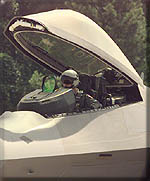 |
Echo CancellationThe key dimension of a quarter wavelength can vary in practice from millimeter to one meter. Although the coating designer will frequently try to use materials whose dielectric constant varies in a way that maintains a constant wavelength independent of frequency, the reality is that a number of different coatings and absorbers are needed to cover the required bandwidth. Imagine a low frequency absorber that might be made of glass fiber hex-cell material. Its resistance is graded from front to back so that the edge is initially electro-magnetically soft and gradually becomes more attenuating as the wave passes through. This approach is particularly taken when, for practical reasons, the layer cannot be as deep as a quarter wavelength. The inner absorber is covered by a high-frequency ferromagnetic coating, which completes the frequency coverage. Metal components such as the engine, which produce significant radar reflections, can be shielded using a metal and plastic sandwich whose layers are spaced in such a way as to create a standing wave, cancelling out any radar reflections. |
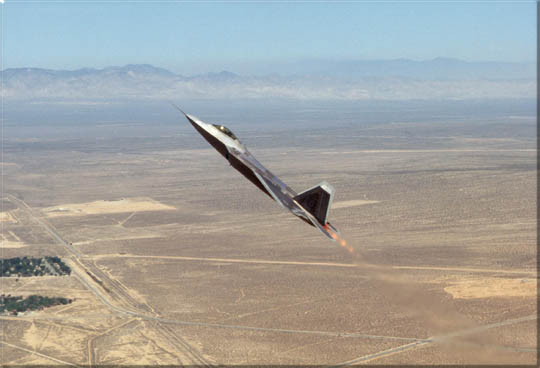 |
|
Turbulence detectionBy optimizing the aerodynamics of the stealth plane, the for the eye invisible turbulence trail in the air, can be kept to a minimum. This way it becomes harder for the very special laser equipment to detect the trail and trace it back all the way to the plane which created it. Visual detection reductionHiding smoke contrails (jet wake) Reducing smoke in the exhaust is accomplished
by improving the efficiency of the combustion chambers. Getting rid of
contrails - that distinct white line in the sky caused by high flying
jets - is a harder task. |
Low visibilityAn aircraft at low to medium altitudes tends to be a black dot against the background of the sky. To avoid this, the plane a given a special medium gray color. The gray, when combined with light scattering at low to medium altitudes ensures about as low observability as can be possible, or a reduction to 30% in visibility. |
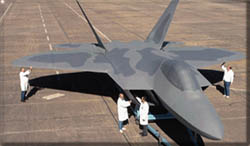 |
|
Low level flight Another technique used by aircraft to avoid radar is to fly at very low
levels where there is a great deal of 'ground clutter' ... radar reflections
given off by buildings and other objects. |
| Board Computer History |
| HOME |